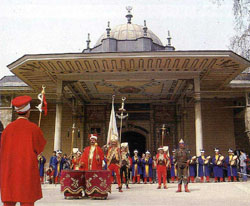|

Throne Room exterior
(Click picture to enlarge)
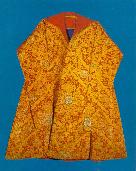
Kaftan of Murat IV
(1623-1640)
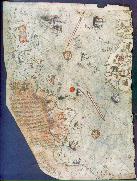
The map of Piri Reis
This map, drown by the Turkish geographer Piri Reis is the oldest known map
that includes the continent of America.
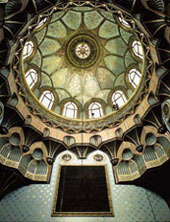
The golden dome of the Holy Relics (Click picture to enlarge)
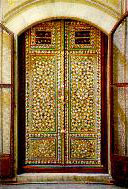
Entrance door of the Sacred Relics Chambers
Decorated with mother-of-pearl. (click pic. to enlarge)
|
As you enter the third court, you'll first see the Throne Room. The
building dates from the reign of Mehmet II, although the door and
decorations date to the 19 century. The building was used mainly for
imperial audiences to viziers and foreign envoys. The Grand Vizier and the
members of Divan were also coming here to present their resolutions to
the Sultan for ratification.
On
the right of the court is a section called "Serefli Kogusu" in which
sultan's costumes are displayed. Next to this is the treasury section
where many precious objects are displayed. Among these objects, is the Topkapi
Hanceri (the Topkapi Dagger). A beautiful dagger ornamented with
valuable emerald pieces was planned to be sent to Nadir Shah of Iran as a
present, but when it was on the way it was heard that Nadir had been
assassinated and so it was taken back to the palace treasury. Relics
including a hand, arm and skull bones belonging to John the Baptist are also
on display in the this section.
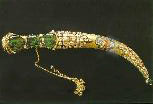
The Topkapi dagger, 1746.
Behind the Throne Room is the elegant library of Ahmet III - "Enderun
Kütüphanesi" built in the early 18th century. It is the largest and finest
library in the palace.
The
buildings on the southwest corner of this court housed the Imperial Enderun,
an institution where young boys from Christian families were trained for
administrative posts in various state departments. It was the Enderun
school, "Has Oda" where the most talented young children were
educated. Today, a superb collection of calligraphy is on display in this
room. Among these is the Map of Piri Reis,
a Turkish geographer and a renowned cartographer of the 16th century. He
drew the oldest map of America in existence. Piri Reis was also a pirate and
admiral who left his mark on Ottoman naval history.
One of the buildings opposite to the third
gate houses a large number of miniatures. Turks had the tradition to
illustrate manuscripts during the cultural periods before Islamic belief.
The oldest illustrated documents on paper among Turkish tribes, are from the
period of Akhuns. These documents dating from 717-719 are in Turkish,
Chinese and Arabic and they belong to a Turkish emir who battled with Moslem
armies in Pencikent near Samarkand. This prince was taken prisoner, and his
palace was ruined 722. The wall drawings are the most important part of
Turkish cultural treasures. Von le Coq who has researched Central Asian
Turkish culture writes: "Turks have scattered all of their written cultural
products in the dusty roads of steppes and deserts while migrating to the
west."
Again in the third court in Topkapi, is The Chambers of the Sacred Relics
where personal belongings of the Prophet Mohammed (a mantle, sword, seal,
tooth, beard and footprints) and Caliphs, religious books, framed
inscriptions and Koran scripts
are on display. All these were
brought to Istanbul when the Ottomans assumed the caliphate of Islam.
The collection of Korans in Topkapi Palace Museum are the richest to be
found anywhere in the world. It includes texts of the Koran inscribed
between the 7th - 19th centuries in Arabia, ran, India, Maghrib (North
Africa) and in the lands dominated by the Seljuks and Ottomans. Almost all
have been prepared by famous calligraphers, gilded by master gilders, and
bound by the most capable bookbinders of the times. The 1600 or more Korans
found in the first volume of the Arabic catalogue are preserved in the
Palace Library as rare books. Among these are seven believed to be inscribed
by caliph Osman (RA), nine accredited to caliph Ali (RA), two ascribed to
Hasan and Hussein (RA) as well as many translations. There are twenty-one
Turkish translations, thirty-nine Farsi translations, twenty-one Chagatay
translations and one Uygur translation.
Further to the left is the vaulted mosque of the white eunuchs "Akagalar
Mosque" which has been restored and now called Topkapi Museums
Library, it houses many books and manuscripts collected from all parts of
the palace. Other buildings in this courtyard include very precious pieces
of clocks, Treasury of the Sword-bearer (Silahtaragası), portraits of
sultans, a pavilion in the time of Mehmet II and the remains of a bathhouse
dating from the reign of Selim II.
|
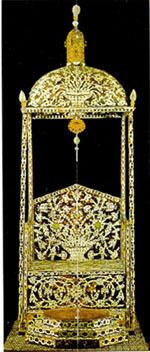
The Throne of Ahmed I
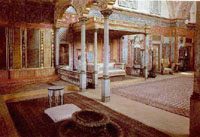
The Throne Room (click on the picture to enlarge)

The Has Oda (click on the picture to enlarge)
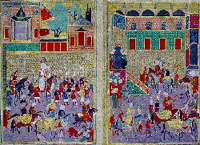
Turkish art of miniatures
 Interior view of Sacred Relics Chamber
(click pic. to enlarge)
|
